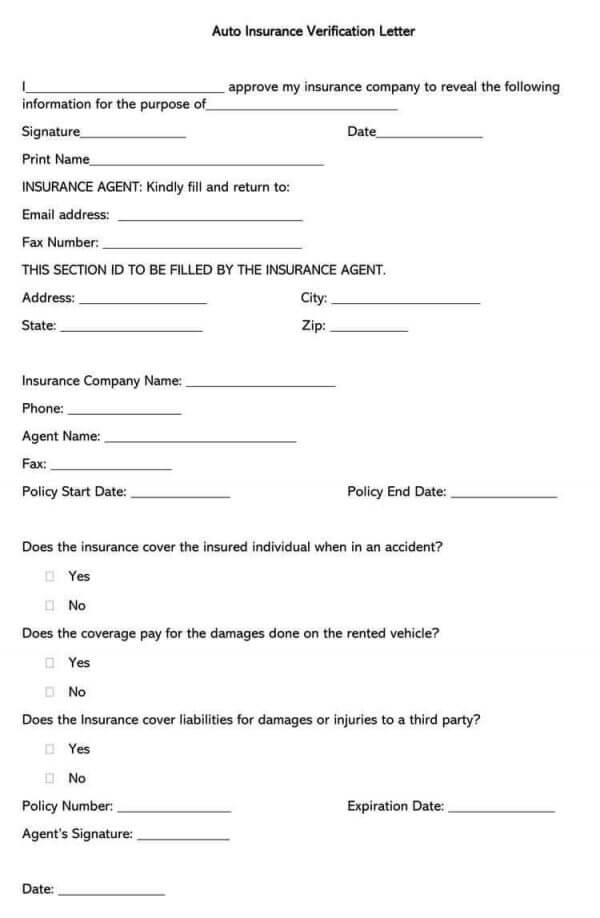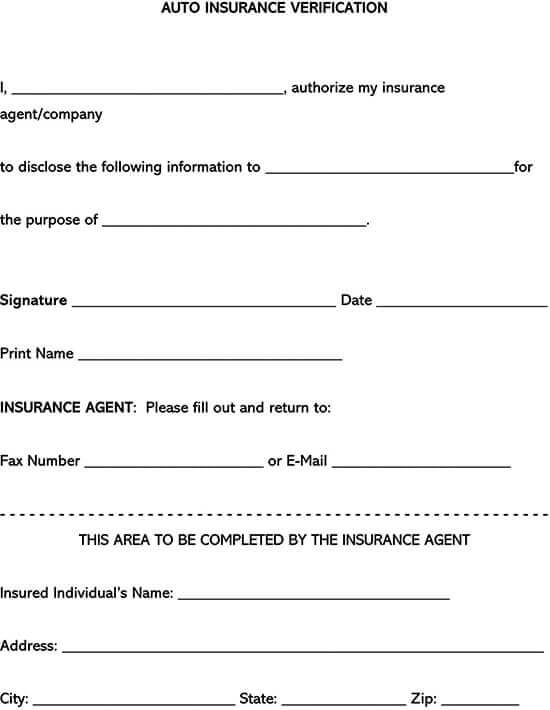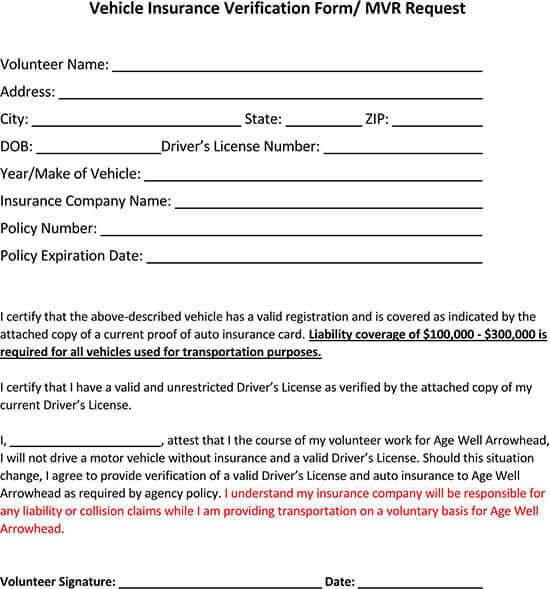An auto insurance verification letter: is a form that confirms to a third party, for instance, a rental car agency or DMV office that a driver has auto insurance. The third party has to present this form to the driver’s insurance provider to obtain accurate information concerning the driver’s insurance policy. As soon as the insurance agent retrieves the requested information against the submitted form, they have to send it back to the requesting party. Drivers may use this form to use the service that the insurance providers guarantee them in case of emergencies such as accidents.
Insurance verification forms serve various purposes. It not only authorizes the driver and ensures them of an insurance policy but also serves as an exceptional reference document in other situations. Some of the benefits of having an insurance verification letter include:
Authentication for insurance coverage: This form serves as an excellent verification document. It proves that you have an insurance policy and can be used when you have been involved in an accident or when purchasing a new vehicle. At times when purchasing a new car, the company agent may look for earlier proof of insurance of your current vehicle. An insurance verification form comes in handy, especially when you’ve been involved in an accident. You can present it to claim the insurance coverage.
Renewal for License Plate: While renewing your license plate, you may have to present an insurance verification form. In most cases, the heads of the department require an authentication document proving that your vehicle is under an insurance policy. An insurance verification letter serves as another reference and comes in handy when processing your renewal.
Revisions of Insurance Policy: when revising your insurance policy, your insurance verification, together with your insurance declaration page, can be used as a reference during and after processing your insurance policy. You can check to see if the company has followed the changes you want for your insurance coverage.
Why is it Important to Have Auto Insurance?
Auto insurance is essential because it protects not only your car but also your financial liability as well. In case you get into an accident and damage someone else’s vehicle or injure them. If you do not have auto insurance, you could potentially be stuck paying for hundreds of thousands of dollars in damages and injuries. Auto insurance protects your vehicle from any damages resulting from an accident or a different covered peril like falling objects, fire, or theft.
Not having car insurance, depending on the state you live in, could be considered an offense. Driving without one could result in fines and license suspension. The primary purpose of having auto insurance is, so you’re able to compensate others for damages you cause. It also helps you avoid any out-of-pocket expenses from a car accident.
What Type of Auto Insurance is Essential to Have?
All insurance policies are made up of several different coverage components, all of which provide essential types of protection. Each type of insurance coverage is necessary; nevertheless, not all coverage components are required by law. Insurance policies vary depending on the state, and some only need liability coverage, which covers bodily injury and property damage you cause someone else. Even though some auto insurance components are optional, it is essential to have more than just the basic coverage required by law.
Below are some of the basics of an insurance cover
- Bodily injury liability: Pays for the medical bills if you’ve injured someone in an accident.
- Property damage liability: this insurance policy covers the amount of property damage you’ve caused in an accident.
- Personal Injury Protection: Covers all the medical expenses for both you and the passenger(s) in the car during an accident
- Uninsured/under insured motorist: Covers the costs if you get involved in an accident by a driver with little or no insurance
- Comprehensive: covers any damages to your car when you are not driving
- Collision: Covers any damages to your car after an accident.
How to Create an Auto Insurance Verification Form
An insurance verification form is also known as proof of insurance. This document authorizes the vehicle owner to use the insurance policy they have signed on the day of the car’s purchase. Regardless of whether you are a third-party or an insurance agent in the agreement, you will be required to present your client with a well-written insurance verification form. This will not only validate your service but also help you gain your client’s trust. Here are some of the things you consider when forming an auto insurance verification form.
Step 1: Know the Insured’s Personal Information
The essential detail you need for a verification form is the holder’s personal information. This information is necessary for the insurance providers to be able to issue an insurance policy to the rightful owners of the vehicle. These details include:
- Client’s name
- Client’s address [city, zip or state]
- The insurance company’s phone number
- The name of the insurance company
- Name of the Agent
- Fax number of the insurance company
Step 2: Discuss the Insurance Coverage
An insurance verification form provides details on the insurance coverage. The client has a right to know the full coverage of the services that shall be availed to them after purchasing the vehicle. You can include the corresponding policies on minor and major accidents like:
- does the insurance cover injuries from the holder?
- Or is it limited to damages to the vehicle?
Auto insurance services vary widely depending on the policies of the insurance company.
Step 3: State the Policy Renewal Dates
Insurance policies have an expiration date. You should always include in your insurance verification form when they should renew their policies. The insurance verification form should also include the company’s name, contact details, and the agent assigned to your clients.
Step 4: Use an Organized Format
The insurance verification form is an official document, and you should use the right format. You can download our already preformatted templates here to help you when writing. This will not only help you write but also help you in making sure that all the necessary details are provided in the form.
Step 5: Affix the Signatures of the People Involved
Just like any other form, and Insurance verification form must contain the signatures of the people involved with the insurance policy. When writing, you can place areas where the insured and the agent can affix their signatures.
This affirms that both parties have agreed with the terms of the insurance policy. The insurance Verification form, together with the vehicle insurance declaration page and any other official documents of your purchase, is then sent to the requesting party.
Sample Auto Insurance Verification Form
I____________________________ approve my insurance company to reveal the following information for the purpose of___________________________
Signature_______________ Date_______________
Print Name_________________________________
INSURANCE AGENT: Kindly fill and return to:
Email address: ______________
Fax Number: ________________
THIS SECTION ID TO BE FILLED BY THE INSURANCE AGENT.
Address: ______ City: _________
State: ________ Zip: _
Insurance Company Name: _________
Phone: ____
Agent Name: _______________
Fax: _____
Policy Start Date: __ Policy End Date: ___
Does the insurance cover the insured individual when in an accident?
Yes
No
Does the coverage pay for the damages done on the rented vehicle?
Yes
No
Does the Insurance cover liabilities for damages or injuries to a third party?
Yes
No
Policy Number: ____ Expiration Date: ___
Agent’s Signature: _
Date: ___
Free Forms
Following are free insurance verification forms that can be customized after being downloaded:
Glossary of Common Auto Insurance Verification Terms
| Agent | An agent is a state-licensed professional representing an insurance company in selling servicing insurance policies. Insurance agents can only sell or service an insurance policy in the states they are licensed in. |
| Binder | This is an acknowledgment from the insurance provider that the insurance for which you applied is in effect regardless of whether you have paid for or received a policy. |
| Bodily Injury (BI) | This coverage protects an insured from financial loss should they be held accountable for any severe losses or damages resulting from an accident. This insurance coverage pays for the pain and suffering inflicted by the insured on the other individual. |
| Cancellation | the dissolution of insurance coverage while still in effect. This is usually due to unpaid premiums. In case of cancellations due to payable premiums, the insurance company is required to send you a ten days’ notice. |
| Claim | this is a request from the insured to the insurance company requesting reimbursement. |
| Collision Coverage | This insurance coverage covers any physical damages to your car if your car hits or is hit by another vehicle or collides with another object, movable or fixed. |
| Contract | This refers to an insurance policy- an agreement between the insurance company and the policyholder. |
| Declarations Page (dec page) | This page contains the necessary details of the policy, i.e., name, and address of the policyholder, the amount and type of coverage, the effective date of coverage, the amounts of the premium, and a description of the covered vehicle. |
| Deductible | This is the amount you agree to pay before your insurance company pays. |
| Endorsement | An endorsement, also known as a “rider,” is a written form attached to a policy altering the terms, conditions, or coverage under the policy. |
| Insured | This is the person entitled to coverage benefits in case of a loss |
| Insurer | The insurance company issuing the insurance |
| Liability Insurance | This insurance coverage covers any losses caused by the insured to other people and their property. |
| Loss | Dollar amount associated with a claim |
| Policy | The written contract of insurance |
| Policy period | The period in which a policy is in effect from the beginning or effective date to the expiration date. |
| Premiums | This is the financial cost of acquiring insurance coverage, paid as a lump sum, or in installments during the duration of the policy. |
| Property Damage (PD) | This is an obligatory no-fault coverage that provides the insured with a fixed amount in loss protection if your car damages someone else’s property. |
| Personal Injury Protection (PIP) | An obligatory no-fault coverage that pays for all rationally necessary medical expenses. It also pays for up to three years of lost wages that had not been hurt, up to a quantified maximum amount. |
| Reinstatement | This is the process by which an insurance company puts a policy back in effect after it has lapsed |
| Rental Reimbursement coverage | This is optional insurance coverage that pays for the repair of car rental under your insurance policy |
| Underwriter | This is the person who reviews applications for insurance to determine if the applicant is eligible for coverage and at what premium rate. |
Frequently Asked Questions
Is auto insurance compulsory?
Yes, Auto insurance is compulsory, according to the Automobile insurance Act. Vehicle owners are required to carry an auto insurance contract. If you get involved in a car accident without carrying insurance, you would have to bear total responsibility for the damages sustained to your vehicle in addition to those caused to a third party. Consequently, you may end up having your driver’s license suspended.
What are the consequences of canceling an insurance contract while it is in force?
You can cancel an insurance contract while it is in force by submitting a written notice signed by the insured(s) party(s) in the agreement. The termination of the insurance contract takes effect at the date the insurer receives the notice or at any date indicated on the contract termination notice.
What happens if I get into an accident and I don’t have car insurance?
Depending on the state you live in, if you are in a car accident and don’t have insurance, you may face fines for not having insurance, plus additional penalties if you are ticketed for the accident. Auto insurance covers not only the other driver’s medical bills but also the cost to replace their car.
What happens if you get pulled over, and you don’t have auto insurance?
Most countries require drivers to have insurance so that they are protected and can afford to pay for any damages in the event of an accident. If you get pulled over, you’ll be asked by the officer, to provide proof of insurance from your car insurance company. If you don’t have it then you may; get a ticket or receive a fine, your license may be suspended, or your car may be impounded.


